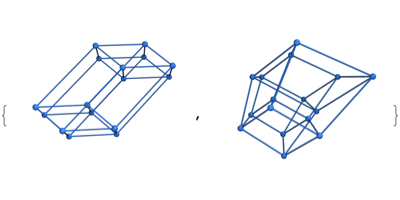

Palmer's company, named nCUBE, was already developing a commercial hypercube. One of the co-founders of one of the companies was John Palmer, a former student of mine and one of the authors of the IEEE 754 floating point standard. Two small groups of Intel engineers had already left the company and formed startups in Oregon. He saw a demo of the Cosmic Cube at a Board meeting and decided that Intel should develop a commercial version. Gordon Moore, one of Intel's founders and then its CEO, was a Caltech alum and on its Board of Trustees. By 1984, Intel had been expanding its operations outside California and had developed a sizeable presence in Oregon. The first startup I joined wasn't actually in Silicon Valley, but in an offspring in Oregon whose boosters called the Silicon Forest.
Hypercube in mathematica code#
They also developed a formidable code to play chess. Among the first were programs for the branch of high energy physics known as quantum chromodynamics (QCD) and for work in astrophysics modeling the formation of galaxies. For example, using binary, node 0101 is connected to nodes 0100, 0111, 0001, and 1101.Ĭaltech Professor Geoffrey Fox and his students developed applications for the Cube. The graphic shows the 16 nodes in a four-dimensional hypercube. So, these machines are called "hypercubes". This corresponds to regarding the nodes as the vertices of a six-dimensional cube and making the connections along the edges of the cube. Connect a node to the nodes whose addresses differ by one bit. Since there are $2^6$ nodes this requires six bits. That required only $6 \times 64 = 384$ connections.

Instead, each node was connected to only six other nodes. That would have required $64^2 = 4096$ connections. It was not feasible to connect a node directly to each of the 63 other nodes. Seitz's group designed a chip to handle the communication between the nodes. There was room on the board of the Cosmic Cube for only 128 kilobytes of memory.
Hypercube in mathematica Pc#
These were the chips that were being used in the IBM PC at the time. Each node was a single board computer based on the Intel 8086 CPU and 8087 floating point coprocessor. Furthermore, when | F v| = f v ≤ n − 2, we prove that there exists the longest fault-free cycle, which is of even length 2 n − 2 f v whether n ( n ≥ 3) and k have the same parity or not and there exists the longest fault-free cycle, which is of odd length 2 n − 2 f v + 1 in Q n,k − F v where n (≥ 3) and k have the different parity.In 1981, Caltech Professor Chuck Seitz and his students developed one of the world's first parallel computers, which they called the Cosmic Cube. When | F v| = 2, we showed that Q n,k − F v contains a fault-free cycle of every even length from 4 to 2 n – 4 where n ( n ≥ 3) and k have the same parity and contains a fault-free cycle of every even length from 4 to 2 n − 4, simultaneously, contains a cycle of every odd length from n − k + 2 to 2 n − 3 where n (≥ 3) and k have the different parity. Let F v be the set of faulty vertices in the n-dimensional enhanced hypercube Q n,k ( n ≥ 3, 1 ≤ k ≤ n − 1). In this paper, we study the enhanced hypercube, an attractive variant of the hypercube and obtained by adding some complementary edges from a hypercube, and focus on cycles embedding on the enhanced hypercube with faulty vertices.


 0 kommentar(er)
0 kommentar(er)
